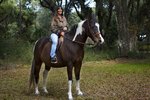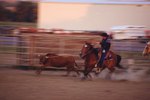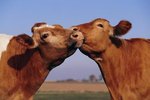
Cattle drives emerged from a growing nation’s demand for beef. Between 1865 and the mid-1890s, cowboys horseback pushed more than 5 million head of longhorn cattle from Texas to the stockyards of Kansas. Today, more than 35 percent of all U.S. farms are beef ranches. Many ranchers graze their cattle on vast stretches of public lands until it’s time to gather the herd. While modern cattle drives are not as long as historic ones, horses remain vital to such ranch activities because they are specialized working animals.
Cow Horses
Just as cattle drives became a part of the beef industry, so did cow horses. In Texas, when the cattle drives began, cowboys needed tough horses for gathering longhorns and pushing them to market. The American quarter horse became the desired cow horse then, and it is still regarded as a valuable ranch horse now. Whether today’s cow horse is pedigreed or unknown, he is a ranch horse gentled to ride, work cattle and perform many tasks for his rider on a cattle drive.
Roundup
Before the cattle drive begins, ranchers and their ranch hands gather the cattle on a “roundup.” A cowboy on foot can’t keep up with the herd, while ATVs can’t navigate narrow trails, deep grass or cross rivers like horses can. Horses help move cattle from one pasture to another or gather cows and calves from grazing lands. Before it snows, ranch hands use their horses to comb the backcountry, collecting cattle over several days. Horses allow ranchers to cover great distances and undeveloped terrains that often have no roads.
Direct Traffic
Horses assist ranchers to direct cattle traffic. Ranch hands position horses and riders around the herd on a cattle drive. One or two might lead the herd, a few others flank it and the rest push from behind. The horses pay attention and are ready to redirect a stray calf or turn the herd left or right. If a bull is tagging along, horses, and most riders, have the sense to simply let him follow the herd. A good ranch horse will sense movement from the herd, displaying intelligence and boldness on a cattle drive.
Calm Minds
One of the reasons that quarter horses are prized for driving cattle even today is for their calmness. If cattle get spooked on a drive, they might stampede or drop weight because of stress. ATVs scare cattle, as often do people on foot. Horses with calm minds respond in a relaxed manner, which helps keep the herd calm and the rider safe.
Cutting
Horses are instrumental in selecting and "cutting" a calf from the herd. The task of cutting is not easy. Because cattle feel secure in the herd, they don’t like to be singled out. The horse has to get in between the calf and the herd, drive it away and not let it return by anticipating and countering each move the calf makes. Some horses are so good at these maneuvers that ranchers compete with others to demonstrate their horses’ skills. The popularity of this practice is now a sport.
Roping
Once a calf is cut from the herd, two riders will need to secure the calf; one ropes the head, the other the hind legs. In that way the calf is stretched out in a safe constraint for vaccinating or ear-tagging. The horse is a roping partner in that he delivers the cowboy into the position to toss the rope. A well-trained horse will even slide into a stop as the rider dallies his rope around the saddle horn. The horse keeps the tension on the rope as needed.
Lifestyle
Horses are important to a lifestyle and industry that is based on the traditional cowboy culture that came out of Texas with cattle drives. Many families still ranch, but cattle drives are disappearing because of costs and modernization. Yet ranchers still do things from horseback. It's an adventurous lifestyle to some, especially for those who have buckaroo blood. Horses will be around as long as the cattle.
References
Resources
Photo Credits
-
Jupiterimages/Photos.com/Getty Images
Writer Bio
Charli Mills has covered the natural food industry since 2001 as a marketing communications manager for a highly successful retail cooperative. She built teams, brands and strategies. She is a writer and editor of "This is Living Naturally," a consultant for Carrot Ranch Communications and a Master Cooperative Communicator.




